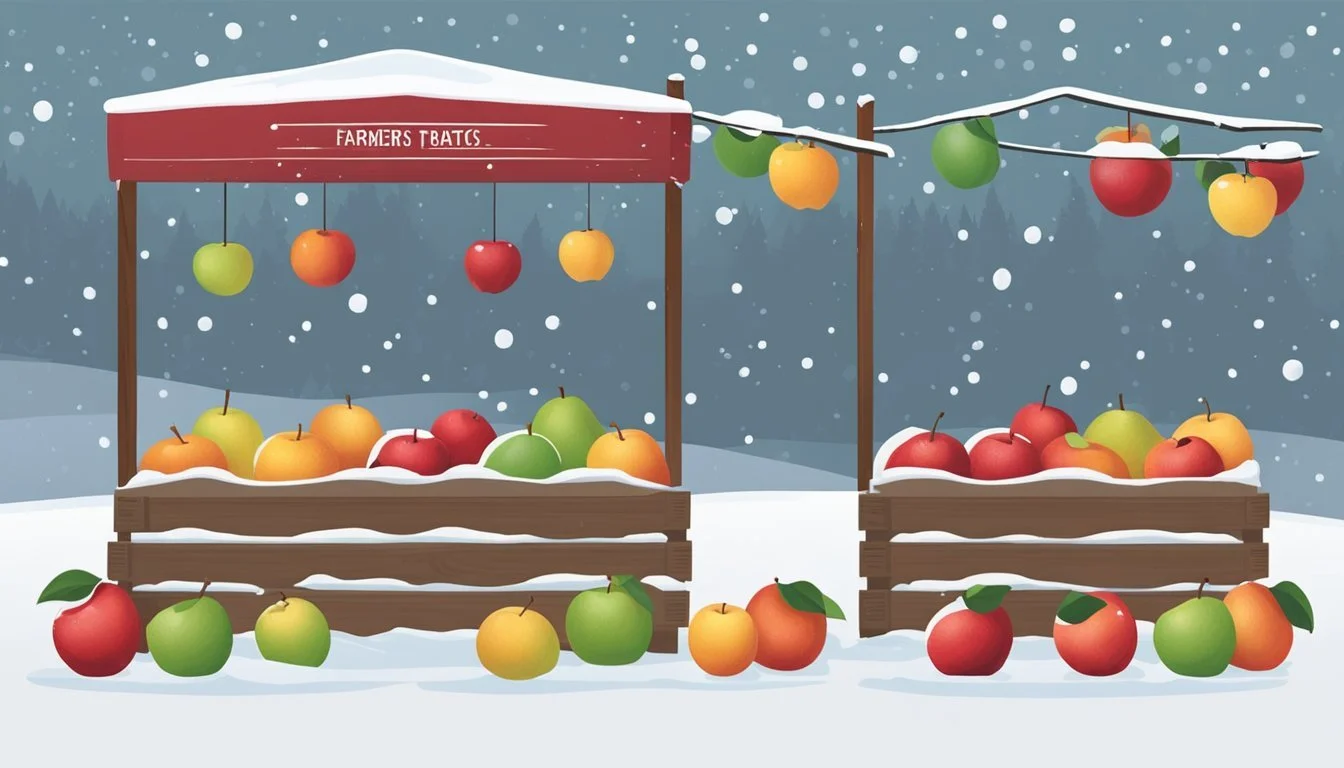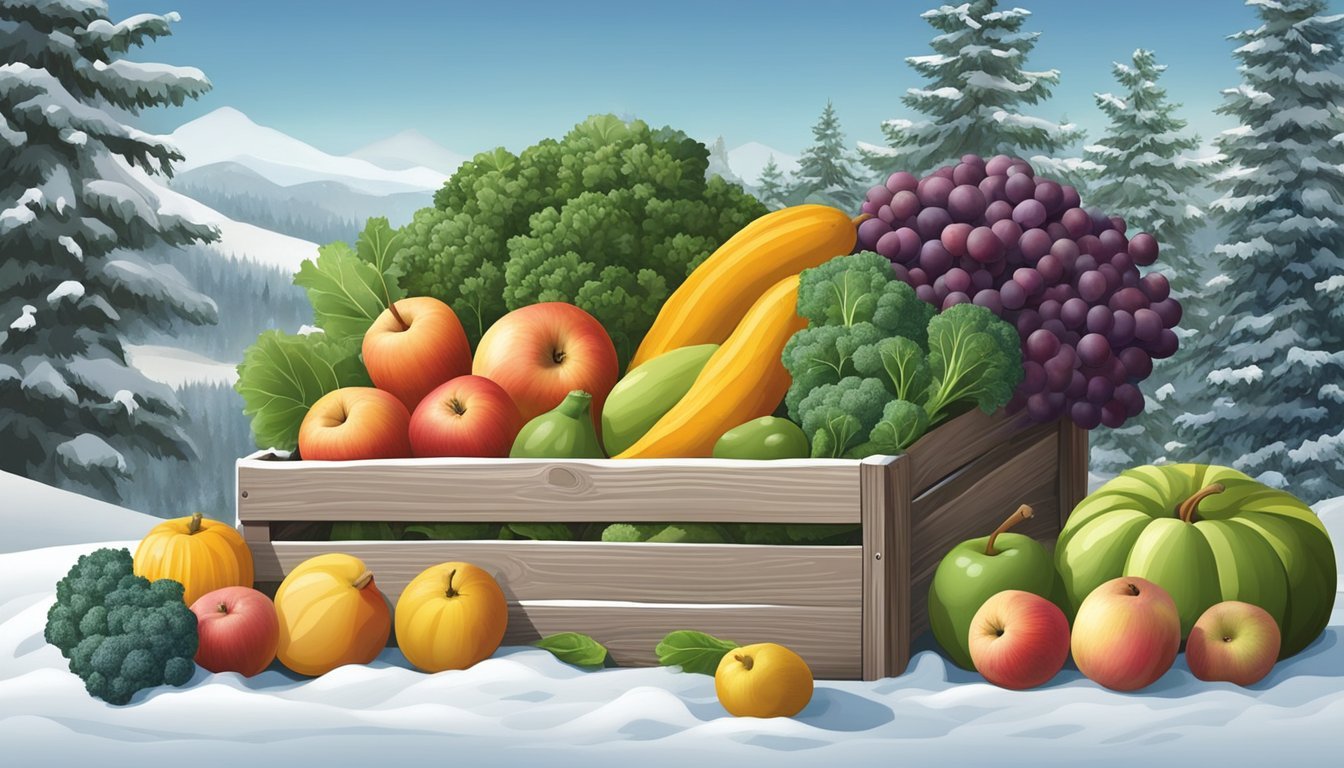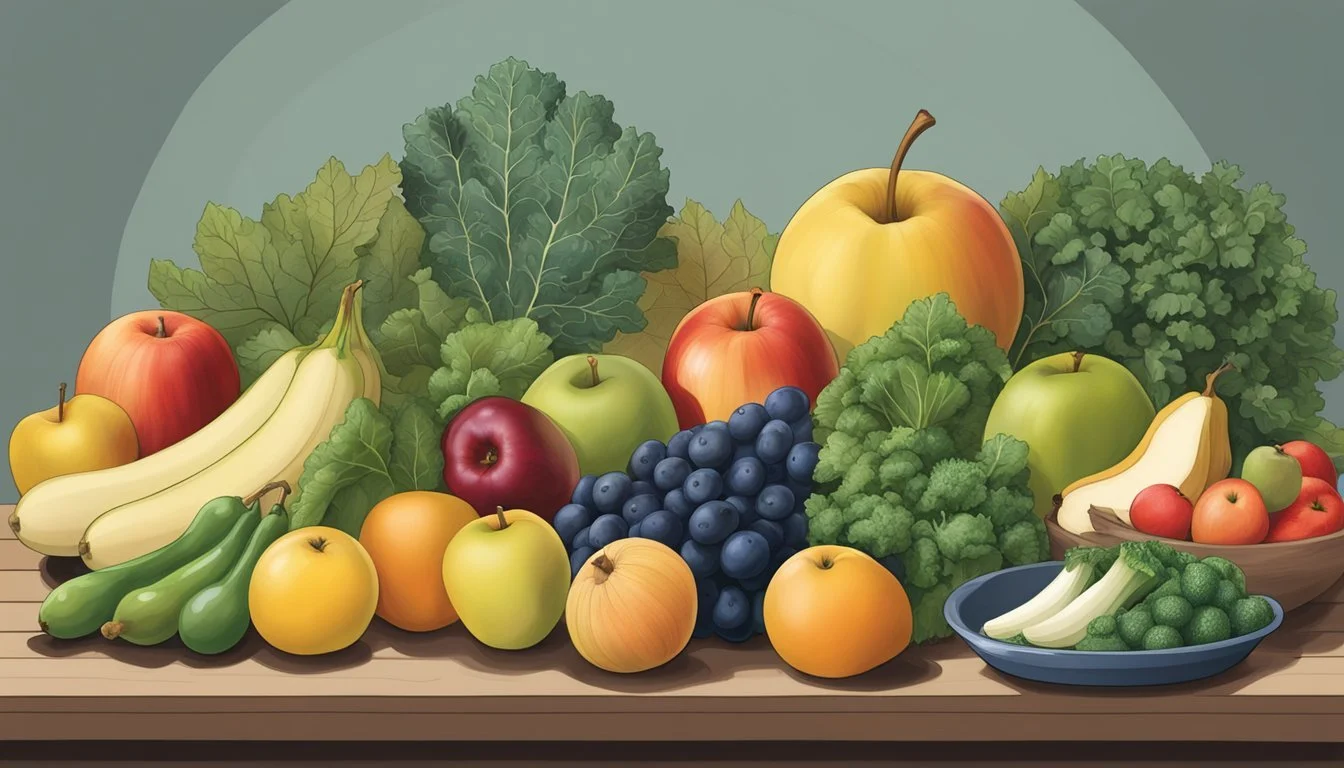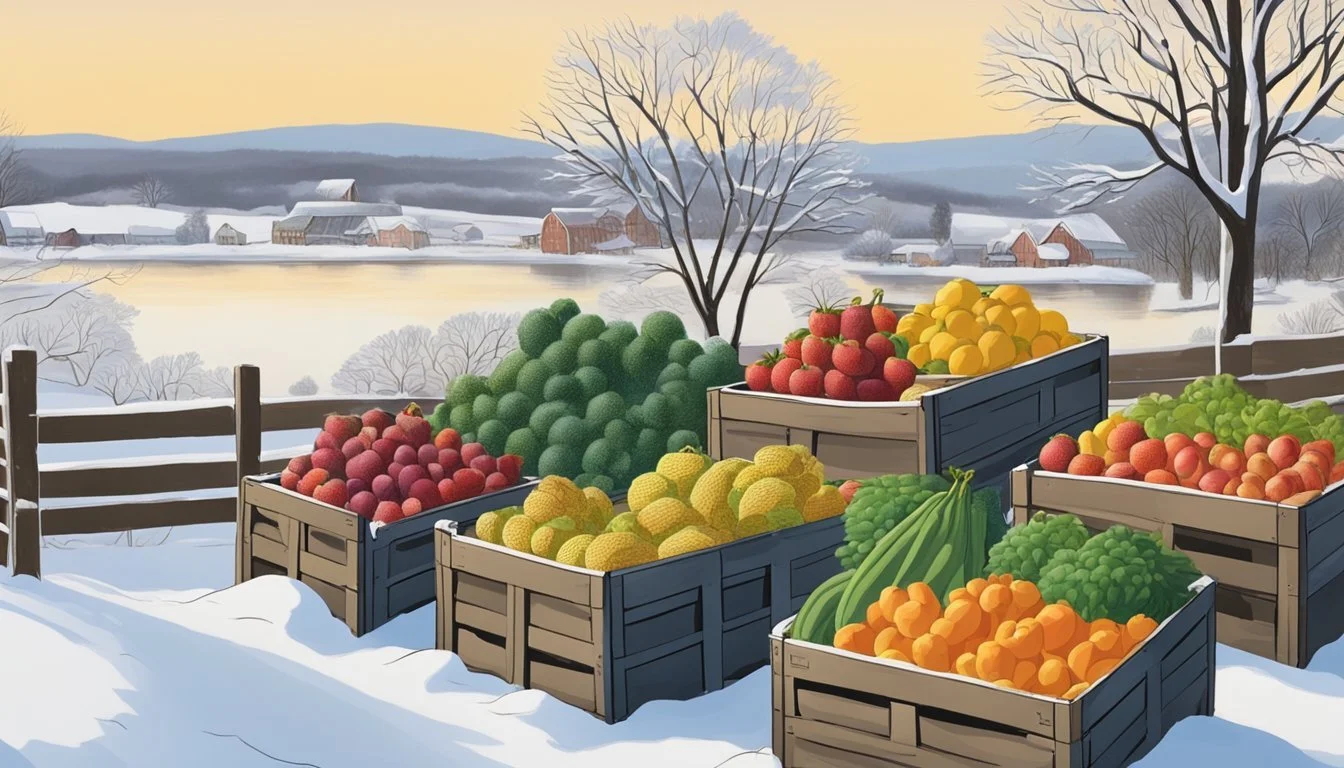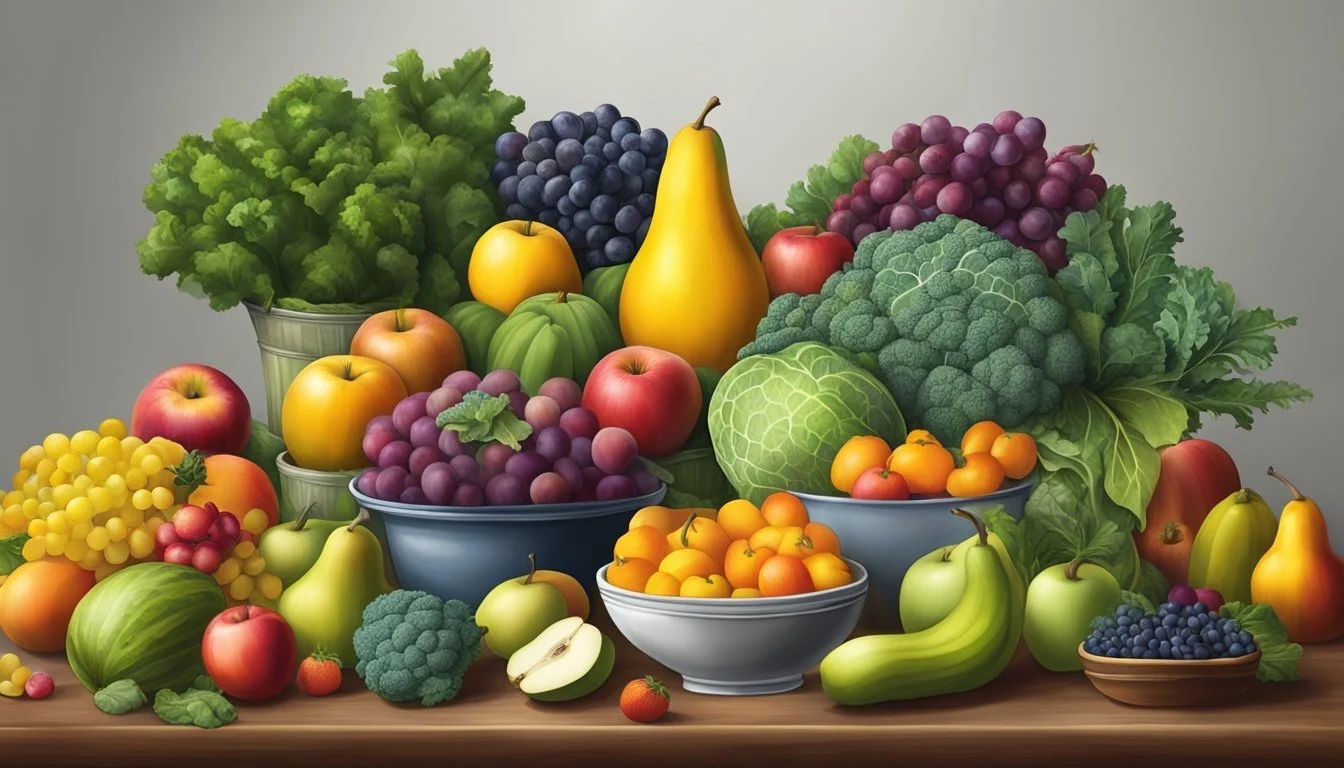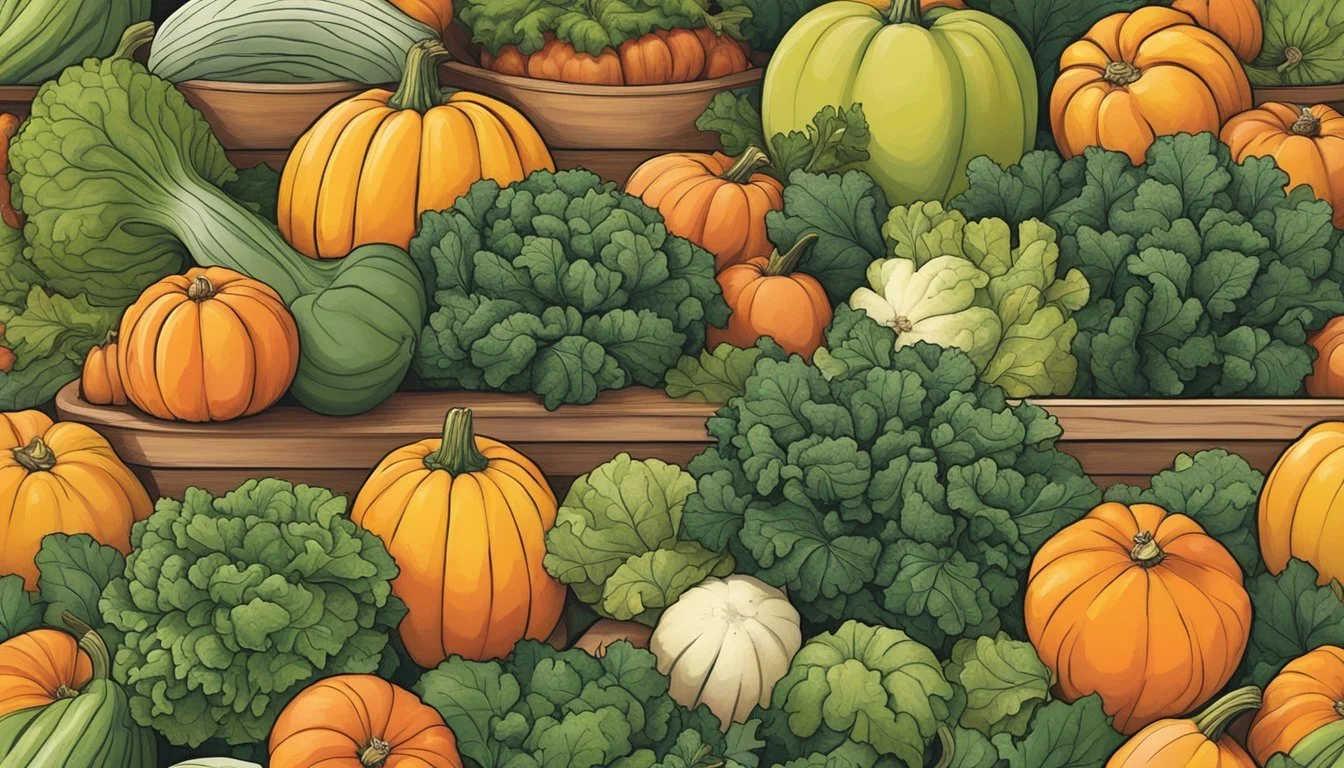Connecticut Seasonal Fruit & Vegetables in December
A Winter Guide
This Article is Part of our Connecticut Seasonal Fruit & Veg Calendar
In the heart of winter, Connecticut offers a unique selection of seasonal fruits and vegetables that not only withstand the cold but also provide essential nutrients during December. The New England climate, characterized by its cold and snowy winters, dictates a distinct growing season. As such, the range of produce available is much different than what one would find in the summer months.
One may find hearty vegetables like kale, Brussels sprouts, and winter squash across markets in Connecticut during this time. These robust vegetables are capable of surviving through the fall and into the colder months, providing residents with farm-fresh options even as the temperatures drop. Root vegetables also tend to dominate the winter offerings, with selections such as turnips, carrots (how long do carrots last?), and potatoes commonly available due to their ability to be stored well after being harvested in the autumn.
Fruits are less abundant in the winter, but certain varieties have their harvest season extend into December. For example, while apples (how long do apples last?) are typically associated with fall, many varieties can be stored and sold well into the winter months, ensuring that Connecticut residents can still enjoy fresh, locally-sourced fruit. Cranberries, too, are a staple of the winter season, often harvested before the first frost and available throughout December. The local produce available in December may not be as varied as the summer months, but it offers its own array of flavors and nutritional benefits.
Overview of Connecticut's December Produce
December in Connecticut is characterized by a colder climate, marking the transition deeper into the winter season. This period significantly influences the types of produce that are available. Farmers and markets in the region adjust accordingly, offering a range of fruits and vegetables that are suited to the lower temperatures and shorter daylight hours.
Vegetables: Emphasizing hardy and cold-tolerant varieties, the selection prominently includes root vegetables and some leafy greens. They retain their quality during the cool months and can be stored for longer periods.
Root Vegetables:
Beets (how long do beets last?)
Carrots
Turnips
Leafy Greens:
Kale
Spinach
Brassicas:
Brussels Sprouts
Cabbage
Fruits: While fresh fruit varieties are limited in December, certain hearty types persist, and storage methods extend availability.
Apples: Stored from earlier harvests and widely available
Pears: Consistent with apples in storage and use
Connecticut's December produce is a testament to seasonal eating, with local farms often providing what is freshly available or well-preserved. The emphasis is on nutrient-rich and versatile vegetables that can withstand the winter's harsher conditions. Consumers may find that these selections offer robust flavors and are well-suited for warming, hearty dishes that are typical of winter cuisine.
Seasonal Fruits Available in December
In Connecticut, December offers a more limited variety of fruits due to the cold climate. However, residents can still enjoy a selection of seasonal fruits that are at their peak during this time.
Citrus Fruits
Clementines and oranges are citrus fruits that typically come into season in the colder months. They are known for their juicy segments and are packed with vitamin C, which can be beneficial during the winter to support the immune system.
Clementines: Abundant from late fall through winter.
Oranges: Harvest begins in late fall and can extend through winter.
Other Winter Fruits
Apart from citrus, other fruits also shine in the winter season of Connecticut. Apples carry over well into December thanks to cold storage techniques, allowing them to remain crisp and flavorful. Pears, much like apples, have a season that extends into the early winter and are a popular choice for both fresh eating and in recipes.
Apples: Varieties vary in availability, with some lasting into winter.
Pears: Available into the early winter, offering a sweet and juicy option.
While not as prominent, cranberries also mark their season in Connecticut. Though they are often associated with autumn, these tart berries can be found fresh in the early winter, making them excellent for holiday dishes.
Cranberries: Fresh cranberries can be found during the early part of December before the end of their season.
Seasonal Vegetables to Enjoy
December in Connecticut offers a variety of fresh vegetables that are perfect for hearty winter meals. From root vegetables that store well during the cold months to greens that can withstand frost, the selection available provides plenty of nutritious and flavorful options for the season's cooking.
Root Vegetables
Root vegetables are stars of the winter table. They store energy in their roots, leading to a rich and often sweet flavor profile.
Carrots: Carrots are versatile and can be enjoyed raw, roasted, or boiled.
Parsnips: These offer a sweet, nutty flavor and are excellent in purees or as a roasted side dish.
Rutabagas: Mild and slightly sweet, rutabagas are ideal for mashing or adding to stews.
Turnips: Their peppery taste softens when cooked and they can be roasted or added to soups.
Potatoes: A staple in many diets, they come in many varieties and are ideal for a range of cooking methods, roasted, mashed, or in stews.
Sweet Squash: Known for its creamy and sweet flesh, it is perfect for soups and baked goods.
Winter Squash: Its thick skin allows it to store well; it's versatile in many dishes, from roasting to soups.
Hearty Greens
Though many might not think of greens as winter vegetables, these hearty varieties can withstand the chilly weather and provide a fresh flavor and rich nutrients.
Kale: This nutritional powerhouse can be sautéed, added to soups, or made into chips.
Broccoli: With both its florets and stems being edible, broccoli is great for stir-fries, steaming, or eating raw in salads.
Other Vegetables
Several other vegetables are also at their peak during Connecticut's winter months.
Brussels Sprouts: When roasted, they become crispy on the outside and tender on the inside.
Cabbage: This versatile vegetable can be used in slaws, sautéed, or fermented to make sauerkraut.
Cauliflower: Available year-round, but best in winter, it can be roasted, steamed, or riced.
These vegetables each bring a unique set of flavors and textures to the winter table in Connecticut and can be a foundation for nutritious and satisfying meals during the colder months.
Freshness and Availability
In December, consumers can relish the freshness of produce from Connecticut's farms and markets, finding items that thrive in the cold or have been preserved through careful storage. Farmers' markets may have reduced offerings due to the winter season, but they remain a source for local, fresh goods.
The following table outlines the fruits and vegetables typically in season and available at Connecticut markets during December:
Fruits Availability Apples In season (cold storage) Pears In season (cold storage)
Vegetables Availability Beets In season Broccoli In season (until early December) Brussels Sprouts In season Cabbage In season Carrots In season Kale In season Leeks In season Potatoes In season Winter Squash In season
It is imperative to note that storage techniques enable some summer and fall harvests, like apples and pears, to remain fresh during the winter months. Thus, consumers continue to enjoy them well into December. Local grocers and farm stands can also be reliable sources for these stored crops, though the variety of available produce might be more limited as compared to peak harvest months.
Individuals seeking the crisp taste of cold-weather crops will find that vegetables like kale and carrots often become sweeter after a frost, enhancing their flavor profile. Shoppers are encouraged to take advantage of what's fresh and to support regional agriculture by visiting their local farmers' markets or farm stands for these seasonal offerings.
Health Benefits of Seasonal Produce
Eating seasonal produce, particularly in December in Connecticut, offers a wealth of health benefits. During this month, root vegetables like beets take center stage; they are not only fresh and abundant but also packed with essential nutrients
Seasonal Recipes for December
With the cold weather settling in, December in Connecticut is perfect for warming up with hearty soups and indulging in the rich flavors of roasted vegetables. (What wine goes well with roasted vegetables?) Hearty root vegetables like carrots and turnips are in season, making them ideal candidates for these types of dishes.
Soups and Stews
During December, soups and stews are essential for both warmth and nutrition. A Classic Carrot Soup utilizes the natural sweetness of carrots, which can be enhanced with a hint of ginger for a warming effect. Alternatively, one could prepare a Hearty Turnip Stew, featuring the earthy tones of turnips paired with seasonal herbs. These dishes not only provide comfort but also allow the flavors of the vegetables to shine through.
Classic Carrot Soup
Ingredients: Carrots, onions, vegetable stock, ginger
Method: Sauté, blend, simmer
Hearty Turnip Stew
Ingredients: Turnips, potatoes, carrots, vegetable broth, thyme
Method: Chop, boil, season
Roasted Dishes
Roasting vegetables transforms them, highlighting their depth of flavor with a delicious caramelization. Simple yet satisfying, a Mixed Vegetable Roast includes carrots, turnips, and any other available root vegetables. For something with a bit more body, one could opt for a Roasted Vegetable Casserole layered with cheese and breadcrumbs for a crispy topping.
Mixed Vegetable Roast
Ingredients: Carrots, turnips, olive oil, rosemary
Method: Chop, toss, roast
Roasted Vegetable Casserole
Ingredients: Roasted carrots, turnips, cheese, breadcrumbs
Method: Layer, bake, broil for crispiness
Incorporating seasonal ingredients into these dishes maximizes the flavor and nutritional content, all while supporting local produce.
Preparing and Storing Seasonal Produce
In December, Connecticut's seasonal produce includes a variety of citrus fruits and hearty vegetables. Preparing and storing these items properly ensures they maintain their sweetness and are enjoyable throughout the winter season.
Citrus Fruits: These winter favorites should be washed under cold running water before being consumed or stored. Citrus fruits can be kept at room temperature for a few days or in the refrigerator for up to a couple of weeks. To retain their juicy texture, they should not be stored in plastic bags.
Root Vegetables: Beets, carrots, and turnips thrive in cold storage. They can be kept in a cool, dark place like a cellar or a refrigerated drawer. Before storing, one should remove any leafy tops to prevent moisture loss and wrap them in paper towels to absorb any excess moisture.
Leafy Greens: Kale and other hearty greens require refrigeration. They should be rinsed, dried completely, and stored in airtight containers lined with paper towels to prolong freshness and prevent wilting.
Winter Squash: Squashes should be kept in a cool, well-ventilated area. They are not as demanding when it comes to humidity and can last for a month or more, making them a reliable winter staple.
Here's a simple guide for storing produce:
Produce Type Preparation Storage Method Duration Citrus Fruits Washed Refrigerator Up to 2 weeks Root Vegetables Tops removed, wrapped Cool, dark place Several weeks Leafy Greens Rinsed, dried Refrigerated, airtight container Up to 1 week Winter Squash None Cool, well-ventilated area Up to 1 month
Proper preparation and storage not only extend the shelf life of produce but also helps maintain the nutritional value, flavor, and texture, making snacks and meals tastier and more beneficial.
The Importance of Seasonal Eating
Seasonal eating relies on selecting and consuming produce that naturally thrives during specific times of the year. Winter in Connecticut, for example, showcases a different range of vegetables and fruits best harvested during the colder months. This practice is more than a culinary trend; it encompasses various benefits that extend to nutrition, the environment, and the economy.
Eating seasonally ensures individuals consume produce when it's at peak freshness. This often translates to higher nutritional value, as fruits and vegetables contain more vitamins when allowed to ripen naturally. During the summer, the body can enjoy a diverse range of berries and stone fruits, while fall brings a bounty of apples and squashes. Rather than opting for out-of-season produce that may have traveled long distances, selecting winter crops like cruciferous vegetables provides robust flavors and dense nutrients.
The environmental impact of seasonal eating cannot be overlooked. It often requires less energy for production and transportation when crops are grown in their ideal season, thus reducing one's carbon footprint. In addition, supporting local agriculture by purchasing seasonal items aids in boosting the local economy and ensures food dollars are kept within the community.
Here are typical seasonal produce items by season in Connecticut:
Spring: Asparagus, lettuce, radishes
Summer: Berries, tomatoes, cucumbers
Fall: Apples, pumpkins, leafy greens
Winter: Root vegetables, winter squash, stored apples and pears
By aligning with the rhythms of nature, individuals can enjoy fresher, tastier, and more nutritious produce while also supporting sustainable practices.
Connecticut's Farming and Agriculture
Connecticut’s agricultural sector is integral to its local economy and cultural heritage. Due to the state’s varying climate and fertile soil, there is a substantial diversity in the types of crops grown. The typical growing season spans from spring through fall, with harvest times fluctuating depending on the crop.
Key Crops:
Fruits: Apples, peaches, pears
Vegetables: Leafy greens, squash, pumpkins
However, in December, the options are limited due to the cold Northeastern winters. Still, some hearty vegetables can withstand the chilly climate, and greenhouses provide a controlled environment for a broader range of produce.
December Harvest:
Outdoor: Root vegetables like carrots and potatoes
Greenhouse-grown: Lettuce, herbs, and some types of tomatoes
Connecticut's agriculture isn't just limited to fruits and vegetables. It also includes dairy, poultry, and nursery plants. Local farmers and producers adapt to the chilly winters by shifting their focus towards these products, which do not rely heavily on the growing season.
Farmers Markets and CSAs:
Availability: Despite the winter, farmers' markets and CSA (Community Supported Agriculture) boxes may still offer limited seasonal produce in December.
Support: They provide a platform for supporting local agriculture year-round.
The state's agriculture department actively promotes Connecticut-grown produce by identifying seasonal availability via helpful resources, ensuring residents have access to fresh, in-state produced goods even in winter months.
Finding Local Produce in December
In Connecticut, December marks the transition into the colder season, but local produce is still accessible for those looking to support community agriculture and enjoy fresh foods. Farmers' markets, often thought of as summer attractions, extend their operations into early winter in many areas, providing opportunities for residents to purchase seasonal goods even during the chillier months.
Despite a decrease in variability, Connecticut farmers' markets continue to offer a range of fruits and vegetables that thrive in the cooler climate or are stored well to last through the winter. Root vegetables and sturdy greens are common finds, with some markets also offering items like apples and winter squash, which have a longer shelf-life.
Local Connecticut produce available in December typically includes, but is not limited to:
Root Vegetables: Such as carrots, turnips, and beets.
Leafy Greens: Including kale and collards.
Winter Squash: Varieties like butternut and acorn.
Apples: Stored from the fall harvest.
Greenhouse-Grown Produce: Including herbs and some lettuces.
Residents looking for fresh, local produce can consult resources like the Connecticut Department of Agriculture for a comprehensive crop calendar and a list of markets operating in the winter. Additionally, many local farms offer CSA (Community Supported Agriculture) shares with selections of the season’s yield, providing a direct line to December's bounty.
Shoppers are encouraged to visit local farmers' markets or contact farms directly to inquire about current offerings, as availability may vary with weather conditions and farm practices.
Conclusion
December in Connecticut offers a variety of fruits and vegetables that are in their prime harvesting time. One can find produce such as cranberries, which are a staple for holiday meals (What wine goes well with holiday meals?), and root vegetables like carrots and potatoes that store well into the winter months.
It's worth noting that hoop houses and other methods are employed to extend the growing season, allowing for a more diverse selection. Consumers can also find winter squash, turnips, and kale, which are resilient to the colder climate.
Here's a brief list of some key December produce:
Fruits:
Cranberries
Apples (stored from fall harvest)
Vegetables:
Carrots
Potatoes
Turnips
Kale
Shoppers are encouraged to support local economies by purchasing these seasonal items from Connecticut's farmers' markets and grocery stores. This practice contributes to sustainable agriculture within the state, promotes the consumption of fresh and nutritious foods, and reduces the carbon footprint associated with long-distance food transportation. The availability of such produce makes it possible for residents to enjoy fresh, seasonal foods even in the midst of winter.



